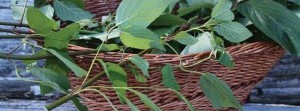
Photo Credit: Carol Ponchet-Cassidy
Soapberry’s gift: Hardworking shrub gives more than it takes
Plants provide us with so much: fresh air, food, fabric, fuel, beauty… the list goes on. We harvest from plants and in turn feed them organic matter in the form of mulch or a manure tea or commercial fertilizer. Some plants, known as nitrogen fixing, create their own fertilizer as well as nourish other plant life nearby. Among them is the soapberry.
The soapberry shrub is a workhorse. Very hardy and tough, it can live in almost any types of soils and locations. It can protect itself from herbivores and the fruit of the soapberry and all of its other plant parts have unique and multiple uses. For these and other reasons, it makes a great addition to any garden or landscaping.
For this article, I will use the common name soapberry, but the reader should be aware that this intriguing native plant has many common names. The ones I found are soapberry, foamberry, buffaloberry, russet buffaloberry, russet red buffaloberry, Canadian buffaloberry and, in old Chinook jargon, soopollalie.
The most important name, the one that never changes, is the botanical Latin name Shepherdia canadensis.
This deciduous shrub can grow up to one to two metres, depending on the conditions. It has a loosely branched, rounded shape. The leaves sit opposite each other on slender branches. They are oval shaped, have smooth margins and a rounded tip. The upper surface of the leaves is a dull, dusty dark green colour and is smooth to the touch.
The underside of the leaf has a unique built-in protection system. It is covered in stiff, bristly, short hairs called scurf that vary in colour from silver to cinnamon-brown. The hairy underside of the leaf is unpalatable to most herbivores and caterpillars (although hares are known to browse the shrub).
Resists fire, calms stomachs
Soapberries fruit best in open, sunny locations. They are commonly found in the shade of the forest canopy or in mountain scree, waste areas, disturbed sites and roadsides, and are hardy down to zone 2, withstanding a minimum temperature of -45 C. Soapberries are not found in Haida Gwaii and are uncommon on Vancouver Island and in the wet coastal forests of the Pacific Northwest.
Soil pH is not an issue for this versatile shrub and it grows well in any type of well-drained soil because of its unusual ability to nourish itself with nitrogen fixing root nodules. Soapberry belongs to a small group of plants that are able to convert nitrogen gas (N2) into usable nitrogen (NH4+). Some nitrogen fixing plants that we may be more familiar with are clover, alfalfa, peas, beans and soybeans.
Canadian and American forestry reports state that soapberry is “moderately resistant to fire”. Generally, after a fire, the lower limbs remain. The soapberry has a large amount of adventitious buds at the crown of the shrub that will shoot readily. After a fire, more opportunities occur for buds to erupt because of increased light and decreased plant competition. Couple this regenerative characteristic with soapberry’s nitrogen-fixing abilities and one can understand why forestry is more and more interested in promoting and encouraging soapberries along roads, logged areas and burn sites.
Soapberry shrubs are dioecious, meaning that some shrubs will bear only male flowers and others only female flowers. Soapberries are also not self-fertile, so a multiple planting of both genders is required to harvest berries. A soapberry shrub needs to be five or six years old before it is mature enough to produce fruit.
The fruit is small, oval, orangey-red and translucent when ripe. The berries are borne at the leaf axils and contain a single seed. The flavour when eaten fresh is often described as very bitter. Soapberries sweeten after a frost. It should also be mentioned that eating soapberries has been reported to be an effective mosquito repellent.
A long legacy
There are many uses for the soapberry fruit. For consumption, the berries can be eaten fresh, made into lemonade, dried, pressed into cakes or whipped into an ancient confection commonly called Indian ice cream. The “ice cream” will be white if green berries are used and pink if ripe berries are used. Never let the berries come into contact with plastic or any other oily containers. The oils will stop any foaming action from occurring.
Soapberries have nutritional value and are very high in vitamin C. They have been used traditionally by First Nations for treating high blood pressure, flu, digestive disorders, bringing on childbirth and externally for acne and boils. Soapberries must be consumed in moderation, however, because they contain a substance called saponin, which can cause stomach upset. The berries can also be used as a shampoo or soap for washing. The mashed berries and subsequent foam feel astringent on the skin and leave a clean, fresh feeling after a good rinse!
The roots, stems, bark and leaves have also been used for medicinal purposes. Boiled twigs and inner bark were used as a laxative. An infusion of the bark was used as eyewash. The bark, mixed with pin-cherry bark and softened in hot water, was used as a plaster or bandage for broken limbs. A brew made from the stems was used for treating digestive upset, stomach cancer, constipation, high blood pressure and venereal disease.
A brew from the stems and leaves was used as a wash for sores, cuts and swellings. This brew was also used as a rub for arthritis and sores on the head and face. The roots are anti-hemorrhagic (stop bleeding) and cathartic (purging and cleansing). The roots have also been used as an aid to childbirth and for treating tuberculosis. The soapberry is truly a multifaceted plant.
Growing at home
Propagation is mostly done by seed. Seeds are collected from ripe fruit in the fall. It is important to not let the seeds dry out as their seed coat becomes very hard. Instead, sow the seeds immediately into an outdoor cold frame. Thin the seedlings in late spring and let them grow on through another winter. Then they can be planted out the following spring.
If you want to store your seeds until spring rather than use a cold frame, prepare the seeds by rubbing them over fine sand paper, then put the seeds into a zip-lock bag filled with clean, moist sand. Place the bag into a brown paper bag to eliminate all light. Put the bag into your refrigerator crisper drawer until the following spring when they can be sown.
Softwood cuttings can be done in July or August using a rooting hormone at 800 parts per million. This is a less reliable method of propagation, and—because of our cold winter climate—the cuttings will need to be protected over winter in a cold frame or green house.
The soapberry is a workhorse of the plant world. It gives back when other plants take. It grows where other plants won’t and it nourishes and prepares barren soil for new plants. The soapberry plant, from bark to berry, from leaf to root, has the capacity to nourish and heal. Thank you, Soapberry.






Where can I find these berries in bc?
👤 Kim 🕔 May 21, 2016
Where can I find these berries in BC
👤 Paula Venn 🕔 Jun 03, 2016
Hi
I like your article about soap berries. I was with someone when they gathered soap berries many years ago and the spread a sheet down under the bush and shook the bush until the berries fell off on tithe sheet. It was fun learning something new. I live in Vancouver and I’m hoping to gather soap berries for a feast. Condo you happen to know of places I can look. I have access to a car.
👤 Sandra 🕔 Jan 30, 2017
then soapberry or nowus as the Ulkatcho people of the west Chilcotin Plateau call it, doesn’t grow on the coast. That made the berries a highly sought after trade item for the Dakelh and Tsilhqot’in people trading with the Nuxalk of Bella Coola for items from the sea…especially oolichan grease.
👤 Sage Birchwater 🕔 Mar 05, 2017